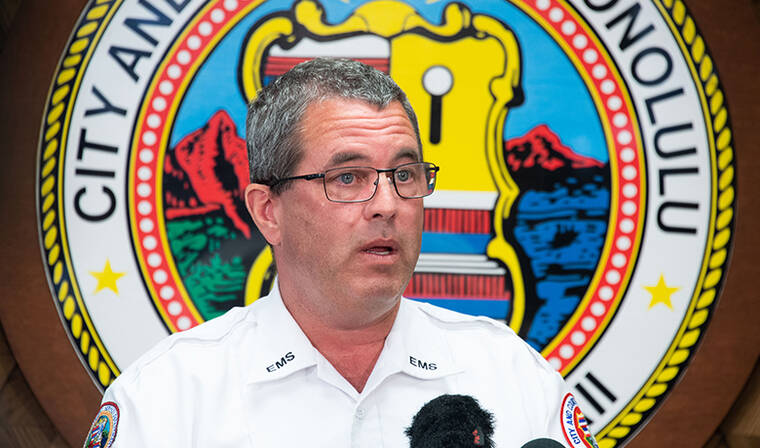Oahu medical calls up 20% since pre-COVID


STAR-ADVERTISER / 2022
Jim Ireland
Honolulu Emergency Services Department director


As the pandemic wanes, Honolulu Emergency Services Department Director Dr. Jim Ireland says medical calls on Oahu have spiked over 20% compared to the pre-COVID-19 years.
“The call volume every year just keeps going up and up and up,” Ireland said Wednesday on the Honolulu Star-Advertiser’s “Spotlight Hawaii” livestream show. “And that’s part of the challenge for our crews to not only provide emergency lifesaving treatment on a daily basis but also keeping up with the volume of calls.”
As to why there’s an increase in medical emergencies, Ireland said he believed the pandemic is partly to blame as people were either less inclined or unable to see physicians for basic health exams.
“And some people just didn’t go to things. They didn’t get screening colonoscopies, they didn’t get mammograms so that takes a toll when you miss things like that,” said Ireland. “And our calls for the ordinary calls, like heart attacks and strokes, high blood pressure and diabetes, that call volume is up.”
He added as Oahu opened to tourists and more people headed outdoors, the numbers of injuries rose as well.
“There’s rescues daily for injured hikers pretty much, people are going out into the ocean more, and there’s still calls for COVID … not a lot of calls, (but) that’s adding to the call volume,” he said.
Don't miss out on what's happening!
Stay in touch with breaking news, as it happens, conveniently in your email inbox. It's FREE!
And calls related to self-harm or suicide attempts also have risen, Ireland said. “Which is really concerning to me because I think that shows people are hurting in our population and they feel helpless; where they’re doing things to hurt themselves and we’re responding to those as well,” he said.
An increase in drug-related overdoses — particularly involving the opiate fentanyl — is also of concern.
“I just noticed that instead of maybe one or two overdoses a day we’d be going on five overdoses a day. There was one day I counted 15 (overdoses),” Ireland said. “And it was young people; I saw one last week as young as 14, and so people are hurting out there and I don’t know why … but really I think we need, at some point, the mental health experts to weigh in and give folks an avenue to get the help (so) they don’t feel they have to do this.”
But Ireland said narcotics like fentanyl do have remedies.
“The good news about fentanyl, if there is any good news, is that it can be reversed with naloxone or Narcan which is available over the counter (and) people can get it free,” he said, adding EMS crews carry Narcan inside city ambulances. “We use it pretty much every day for something, and it will reverse the effects of narcotics, fentanyl in particular, if we get to them in time.”
Ireland noted that the Honolulu City Council is now considering a bill which would require local bars to stock Narcan in case of fentanyl-related overdoses.
However, dangerous new drugs — including a powerful horse tranquilizer called Xylazine, also known as “Tranq” — also have arrived on the island. Originally from Puerto Rico and used by veterinarians, Xylazine can often be mixed, or cut, with other drugs, including fentanyl and cocaine, according to Ireland.
“The treatment is different for an overdose from Tranq than it is for fentanyl,” Ireland explained. “Narcan will not wake you up from an overdose of Xylazine; it’s a completely different treatment … it’s more supportive care, there is no antidote.”
Meanwhile, as the calls for medical service increase so does the need for the increased staffing of EMTs. To help fill those positions, Ireland said the city’s EMT academy — in partnership with Kapiolani Community College — will begin this summer.
“We have around 40 to 45 slated to start in July, and that’s to fill 25 vacancies,” he said. “So we feel by the end of the year we will be robust with our staffing.”
Besides the academy, the city is hiring graduates from KCC’s own EMT program. “We’re hoping to bring on another 10 or 15 people that have already completed their training at KCC,” Ireland said.
In addition, Ireland said his department is expected to add to its existing fleet of 22 ambulances.
“I think we really need to get to 30 ambulances on Oahu,” he said, adding that number will allow the city to catch up with rising calls for service.
In the city’s latest proposed $3.41 billion operating budget — pending passage by early June — new ambulances have been included to cover parts of urban Honolulu.
“And that’s why we’re proposing in our budget that Kalihi and Kakaako will add to that town response,” Ireland said, noting the goal is to add one or two ambulances a year for the next five years.



